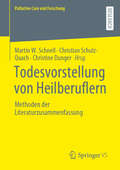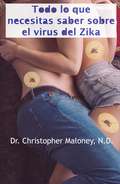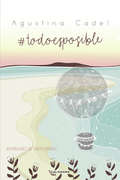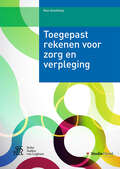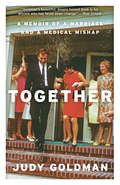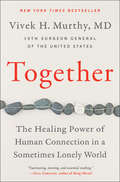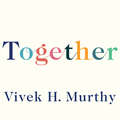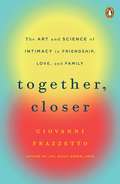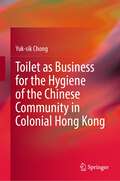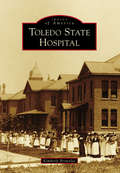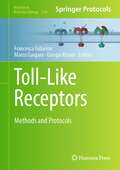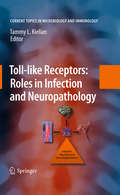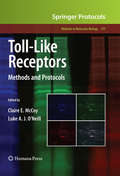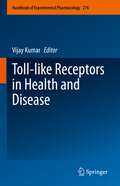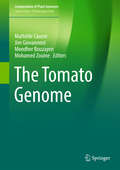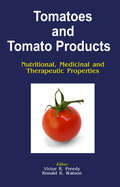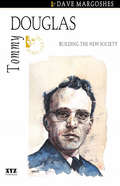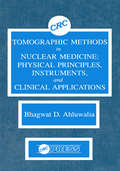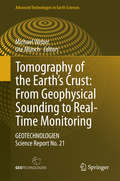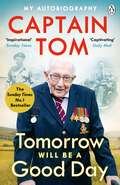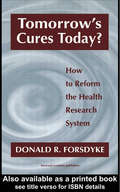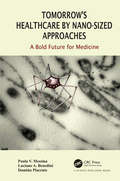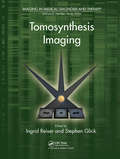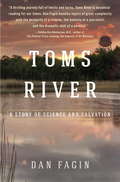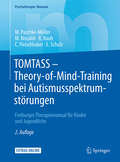- Table View
- List View
Todesvorstellung von Heilberuflern: Methoden der Literaturzusammenfassung (Palliative Care und Forschung)
by Martin W. Schnell Christine Dunger Christian Schulz-QuachHeilberufler, d.h. Ärzt*innen, Pflegende und Vertreter anderer Professionen, die in der Versorgung sterbender Menschen und deren Angehöriger tätig sind, haben Vorstellungen vom Tod ausgebildet. Diese leiten die Behandlungsweise von sterbenden Menschen, da sie Antworten auf fundamentale Fragen geben. Was ist der Tod? Wann tritt ein Mensch in seine letzte Lebensphase ein? Todesvorstellungen sind meist Mischkonzepte. Wissenschaft, Berufserfahrung, Mythologie, Religion, allgemeine Werte gehen in sie ein. Die vorliegende Publikation erforscht die Todesvorstellungen von Heilberuflern und stellt sie in ihrer Diversität dar. Der Band führt dabei Methoden der Literaturzusammenfassung vor, die von fortgeschrittenen Studierenden, Doktoranden und jungen Forscher*innen verwendet werden können, um einen relevanten Forschungsstand zu dokumentieren. Eine wissenschaftshistorische und methodische Reflexion fundiert diese Vorstellung.
Todo lo que necesitas saber sobre el virus del Zika
by Ana Rodríguez Díaz Dr Christopher Maloney N. D.¿Te da miedo el virus del Zika? ¿Todavía piensas que se propaga sobre todo por los mosquitos? ¿Sabes que hay otros animales que albergan el Zika? ¿Tienes idea de cuánto tiempo lo podemos tener en el cuerpo y contagiar a otras personas? El Dr. Maloney explica de forma sencilla las investigaciones más recientes sobre la propagación del Zika y sobre el hecho de que el virus produzca efectos secundarios graves, como anomalías genéticas y parálisis. Ofrece una posible explicación sobre por qué algunos bebés se ven afectados y otros no. El Zika es al mismo tiempo más y menos peligroso de lo que nos han contado. Aquí puedes aprender rápidamente a mantener a tu familia a salvo del Zika.
#TodoEsPosible
by Agustina Cadel¿Sueñas lo suficiente? Alice ha perdido un momento, un instante que ha naufragado en el mar de su memoria y que podría haber cambiado su vida por completo. Su búsqueda define la exquisita aventura que se dispone a vivir: un viaje en globo que la llevará a descubrir paisajes en su interior que desconocía y que no tardan en desvelarle los secretos de una vida feliz. Una novela fresca y sencilla que nos transporta a un mundo imaginario pero tangible, y que lleva tatuado un mensaje de esperanza e indicaciones simples para adentrarse en el camino del autodescubrimiento. «Sirve, ama, da, purifica, medita, realízate.»Swami Sivananda
Toegepast rekenen
by Ron GroothuisAls docent rekenen huldigde Ron Groothuis het principe dat iedereen kan rekenen en dat rekenen spannend, leuk en uitdagend is. Wat leerlingen belemmert, is het idee dat ze niet kunnen rekenen. Niets is echter minder waar! Samen met zijn leerlingen ontwikkelde Groothuis een lesprogramma waarin de dagelijkse maar ook de spectaculaire kanten van het rekenen naar voren kwamen. 'Toegepast rekenen voor zorg en verpleging' is de neerslag van dit lesprogramma. Het stelt de leerlingen in staat om in en naast de lessen de stof zelfstandig te leren ontdekken en beheersen. Alle belangrijke rekenelementen waar de student later in de praktijk mee te maken krijgt, worden geoefend. Ron Groothuis volgde de opleidingen NLO Maatschappij/Huishoudkunde en MO-A Pedagogiek. Hij geeft sinds 1984 trainingen en scholing in de zorgsector. Tevens is hij werkzaam in de zorg in diverse staf- en managementfuncties. Kijk voor de tekst online, studie-links, meer opdrachten en samenvattingen op www. studiecloud. nl
Together: A Memoir of a Marriage and a Medical Mishap
by Judy GoldmanA routine procedure left novelist, memoirist, and poet Judy Goldman's husband paralyzed. Together is her unforgettable account of the struggle to regain their "normal" life and a nuanced portrait of a marriage tested.When Judy Goldman's husband of almost four decades reads a newspaper ad for an injection to alleviate back pain, the outpatient procedure sounds like the answer to his longtime backaches. But rather than restoring his tennis game, the procedure leaves him paralyzed from the waist down--a phenomenon none of the doctors the family consults can explain. Overnight, Goldman's world is turned upside down. Though she has always thought of herself as the polite, demure wife opposite her strong, brave husband, Goldman finds herself thrown into a new role as his advocate, navigating byzantine hospital policies, demanding and refusing treatments, seeking solutions to help him win back his independence. Along the way, Goldman flashes back to her memories of their life together. As she tries envision her family's future, she discovers a new, more resilient version of herself. Together is a story of the life we imagine versus the life we lead--an elegant and empathetic meditation on partnership, aging, and, of course, love.
Together: The Healing Power of Human Connection in a Sometimes Lonely World
by Vivek H MurthyIn this groundbreaking book, Former Surgeon General of the United States, Vivek Murthy argues that loneliness is the underpinning to the current crisis in mental wellness and is responsible for the upsurge in suicide, the opioid epidemic, the overuse of psych meds, the over-diagnosing and pathologizing of emotional and psychological struggle. <P><P>The good news is that social connection is innate and a cure for loneliness. In Together, the former Surgeon General will address the importance of community and connection and offer viable and actionable solutions to this overlooked epidemic. <P><P><b>A New York Times Bestseller</b>
Together: Loneliness, Health and What Happens When We Find Connection
by Vivek H. Murthy'The most important book you'll read this year.' DANIEL H. PINK, author of Drive'Together stands with Atul Gawande's classic, Being Mortal.' MALCOLM GLADWELL, author of Outliers'A welcome beacon towards meaningful connection' ARIANNA HUFFINGTON, author of Thrive'Fascinating, moving and essential reading.' ATUL GAWANDE, author of Being Mortal'This book is a gift' SUSAN CAIN, author of Quiet'Exactly what the doctor ordered' ANGELA DUCKWORTH, author of GritThe world seems more connected than ever, and yet loneliness is at epidemic levels. But what effect is it having on us, and how can we treat it - even at a distance?When Obama appointed him Surgeon General of the United States, Dr Vivek Murthy observed the growing health crisis of isolation first-hand. In this ground-breaking book, he traces the roots of the problem, and shows how loneliness lies behind some of our greatest personal and social challenges, from anxiety and depression to addiction and violence. But he also reveals the cure. His search led him to talk to doctors, scientists, parents and community members around the world. The solutions are deceptively simple and easily applicable - and the effects are transformative. And one thing is clear: real human connection is a medical necessity if we want to stay healthy. We can all create it, and benefit from it, and it is more urgent than ever that we start now.
Together, Closer: The Art and Science of Intimacy in Friendship, Love, and Family
by Giovanni FrazzettoFor readers of Oliver Sacks and Stephen Grosz, a wondrous, deeply felt book that explores intimacy through the stories of eight relationships, from the author of Joy, Guilt, Anger, Love The bonds we are capable of feeling toward other people—how we know and belong to one another—provide fascinating glimpses into the intricacies of human behavior. Intimacy is that moment when our true identity is revealed to another, when traumas, fears, and ambitions are shared. Through the ordinary stories of eight relationships, Giovanni Frazzetto has woven an extraordinary narrative of togetherness. He shares the details of romantic partners trapped in a long cycle of attraction and rejection, a single woman who finds herself deep in a fictional relationship with a boyfriend she has invented out of frustration with her love life, and a couple absorbed in a years-long clandestine affair. But intimacy can also extend beyond romantic encounters: coping with the loss of a loved one, dealing with overbearing or emotionally distant parents, or celebrating the joys and comforts of our dearest friends. In Together, Closer, Frazzetto unravels the components of intimacy in all of these relationships, illuminating the mysteries, challenges, and pleasures of intimacy through a brilliant mix of storytelling and science. Praise for Giovanni Frazzetto’s Joy, Guilt, Anger, Love: “In Frazzetto’s book, the Italian researcher and writer offers a fine primer on six emotions plus empathy. But before diving into the biology of each emotion (the role of the amygdala in fear and of serotonin reuptake in grief), he inspects his target through the lenses of psychology, philosophy, art, and personal experience. What you see is that poetry offers more insight into our feelings than does neuroanatomy or biochemistry.” —The Washington Post
Toilet as Business for the Hygiene of the Chinese Community in Colonial Hong Kong
by Yuk-sik ChongThis book analyses how public toilets were provided by the government and local business in Hong Kong between the 1860s and 1930s through a process that was embedded in class and racial politics. Addressing public toilet provision from a political economy perspective, it focuses on the interplay of the cross-border night soil business between Hong Kong and China’s silk producing area; the silk market between China and Colonial powers; the Hong Kong land market between the colonial government and Chinese business; and how these factors jointly produced a network of toilets in the colony. As the book shows, the commercial viability of toilets created multiple logics and a new moral geography; further, exploring the topic can help us gain a better understanding of how urban governance functioned in colonies and how it intertwined with economic contingencies within a global economic system. The intended readership includes academics and members of the general public with an interest in colonialism, public infrastructures, public health, government–business relations, and urban governance.
Toledo State Hospital (Images of America)
by Kimberly BrownleeThe Toledo State Hospital opened in 1888, and its design and healing approach were revolutionary for the time. First in the country built entirely on the "cottage model," its plan was intended to create a homelike atmosphere in a beautifully manicured landscape. Treatment methods were based on the "moral treatment" philosophy, the belief that calming surroundings with nutritious food, productive work, and diversion would help the disturbed mind to heal. Over the years, facilities were expanded to serve a burgeoning patient population, and medications and treatments evolved. In the 1950s, however, the population began a steady decline due to the advent of services in the community and to advances in psychotropic drugs. As the old buildings were emptied, they were demolished, and all were gone by 1981.
Toll-Like Receptors: Methods and Protocols (Methods in Molecular Biology #2700)
by Francesca Fallarino Marco Gargaro Giorgia ManniThis volume provides methods on the role of TLRs in immune responses and on the various approaches targeting different TLRs in cancer, autoimmunity and in vaccine development. Written in the highly successful Methods in Molecular Biology series format, chapters include introductions to their respective topics, lists of the necessary materials and reagents, step-by-step, readily reproducible laboratory protocols, and key tips on troubleshooting and avoiding known pitfalls. Authoritative and cutting-edge, Toll-Like Receptors: Methods and Protocols aims to be a useful and practical guide to new researchers and experts looking to expand their knowledge.
Toll-like Receptors: Roles in Infection and Neuropathology
by Tammy KielianMammalian Toll-like receptors (TLRs) were first identified in 1997 based on their homology with Drosophila Toll, which mediates innate immunity in the fly. In recent years, the number of studies describing TLR expression and function in the nervous system has been increasing steadily and expanding beyond their traditional roles in infectious diseases to neurodegenerative disorders and injury. Interest in the field serves as the impetus for this volume in the Current Topics in Microbiology and Immunology series entitled "Toll-like receptors: Roles in Infection and Neuropathology". The first five chapters highlight more traditional roles for TLRs in infectious diseases of the CNS. The second half of the volume discusses recently emerging roles for TLRs in non-infectious neurodegenerative diseases and the challenges faced in these models with identifying endogenous ligands. Several conceptual theories are introduced in various chapters that deal with the dual nature of TLR engagement and whether these signals favor neuroprotective versus neurodegenerative outcomes. This volume should be informative for both experts as well as newcomers to the field of TLRs in the nervous system based on its coverage of basic TLR biology as well as specialization to discuss specific diseases of the nervous system where TLR function has been implicated. A must read for researchers interested in the dual role of these receptors in neuroinfection and neurodegeneration.
Toll-Like Receptors
by Luke A.J. O'Neill Claire E. MccoyIn addition to their invaluable role in the fight against infection, Toll-Like Receptors (TLRs) in an under- or over-active state can lead to the pathogenesis of disease, making these receptors a key focal point for many research laboratories. In Toll-Like Receptors: Methods and Protocols, experts in the field contribute techniques currently used to study TLRs, their downstream signalling pathways, and their role in the pathogenesis of disease, with sections examining TLR expression and the application of genetic techniques and microarray analysis to TLR research. Written in the highly successful Methods in Molecular BiologyTM series format, chapters include brief introductions to the topics, lists of the necessary materials and reagents, step-by-step, readily reproducible laboratory protocols, and Notes sections highlighting tips on troubleshooting and avoiding known pitfalls. Versatile and cutting-edge, Toll-Like Receptors: Methods and Protocols provides an ideal manual for a wide range of biologists and medical researchers studying these vital components of the immune system.
Toll-like Receptors in Health and Disease (Handbook of Experimental Pharmacology #276)
by Vijay KumarThe current book is focussed on the Toll-like receptors (TLRs), which are the first pattern recognition receptors (PRRs) discovered in humans. For example, TLR4 was first recognized in humans in 1997 as a PRR recognizing the Gram-negative bacterial lipopolysaccharide (LPS). This discovery revolutionized the field of innate immunity and filled the long-standing gap in the pathogen recognition by the immune system. Now, it is well established that humans have 10 (TLR1-TLR10) and mice have 12 (TLR1-TLR13) functional TLRs, excluding TLR10 that is present as a defective pseudogene. TLRs are present as both membrane-bound extracellular (TLR1, TLR2, TLR4, TLR5, TLR6, and TLR10) and intracellular (TLR3, TLR7, TLR8, and TLR9) PRRs in humans, which identify different pathogen or microbe-associated molecular patterns (PAMPs or MAMPs) and death or damage-associated molecular patterns (DAMPs) released by the host cells. A lot of development in the TLR biology has occurred in last 24 years since there first discovery in humans.The book is intended to describe their role in the host defence, human reproduction, non-infectious sterile inflammatory conditions, including brain immunity and cerebrovascular diseases, signaling mechanisms, adaptive immunity, and their targeting for drug development.
The Tomato Genome
by Mathilde Causse Jim Giovannoni Mondher Bouzayen Mohamed ZouineThis book describes the strategy used for sequencing, assembling and annotating the tomato genome and presents the main characteristics of this sequence with a special focus on repeated sequences and the ancestral polyploidy events. It also includes the chloroplast and mitochondrial genomes. Tomato (Solanum lycopersicum) is a major crop plant as well as a model for fruit development, and the availability of the genome sequence has completely changed the paradigm of the species' genetics and genomics. The book describes the numerous genetic and genomic resources available, the identified genes and quantitative trait locus (QTL) identified, as well as the strong synteny across Solanaceae species. Lastly, it discusses the consequences of the availability of a high-quality genome sequence of the cultivated species for the research community. It is a valuable resource for students and researchers interested in the genetics and genomics of tomato and Solanaceae.
Tomatoes and Tomato Products: Nutritional, Medicinal and Therapeutic Properties
by V. R. PreedyThe contributors to this book are authors of international and national standing, leaders in the field and trendsetters. The book covers emerging fields of science and important discoveries relating to tomatoes and related products. This represents a one-stop shopping of material related to tomatoes. This book will be essential reading for plant sc
Tommy Douglas
by Dave MargoshesDuring the 17 years he was premier of Saskatchewan, Tommy Douglas changed the face of his province. He then served for 10 years as first leader of the federal New Democratic Party. Today he is recognized as the "father of medicare." In 2004, CBC TV viewers voted him the "Greatest Canadian."
Tomographic Methods in Nuclear Medicine: Physical Principles, Instruments, and Clinical Applications
by Bhagwat D. AhluwaliaThis publication is a compendium of physical principles, system descriptions, instrument quality assurance, and clinical applications of extant tomographic methods in nuclear medicine. Written by an expert in this pertinent field, each chapter deals with the topics in a comprehensive fashion to provide a ready reference of all the work done on the subject and an estimate of the future utilization. Descriptions of methods available to nuclear medicine for tomographic viewing include positron emission, single photon emission, and planar tomography. This is an excellent resource volume of general applicability for nuclear medicine physicians, nuclear medicine scientists, and researchers in organ imaging and processing techniques.
Tomography of the Earth's Crust: From Geophysical Sounding to Real-Time Monitoring
by Michael Weber Ute MünchThe research work on the topic of ''Tomography of the Earth's Crust: From Geophysical Sounding to Real-Time Monitoring'' has focused on the development of cross-scale multiparameter methods and their technological application together with the development of innovative field techniques. Seismic wave field inversion theory, diffusion and potential methods were developed and optimized with respect to cost and benefit aspects. This volume summarizes the scientific results of nine interdisciplinary joint projects funded by the German Federal Ministry of Education and Research in the framework of the Research and Development Program GEOTECHNOLOGIEN. Highlights and innovations presented cover many length scales and involve targets ranging from applications in the laboratory, to ground water surveys of heterogeneous aquifer, geotechnical applications like tunnel excavation, coal mine and CO2 monitoring and the imaging and monitoring of tectonic and societally relevant objects as active faults and volcanoes. To study these objects, the authors use the full spectrum of geophysical methods (ultrasonics, seismic and seismology, electromagnetics, gravity, and airborne) in combination with new methods like seismic interferometry, diffuse wave field theory and full-wave-form inversion in 3D and partially also in 4D. Geophysical Sounding to Real-Time Monitoring'' has focused on the development of cross-scale multiparameter methods and their technological application together with the development of innovative field techniques. Seismic wave field inversion theory, diffusion and potential methods were developed and optimized with respect to cost and benefit aspects. This volume summarizes the scientific results of nine interdisciplinary joint projects funded by the German Federal Ministry of Education and Research in the framework of the Research and Development Program GEOTECHNOLOGIEN. Highlights and innovations presented cover many length scales and involve targets ranging from applications in the laboratory, to ground water surveys of heterogeneous aquifer, geotechnical applications like tunnel excavation, coal mine and CO2 monitoring and the imaging and monitoring of tectonic and societally relevant objects as active faults and volcanoes. To study these objects, the authors use the full spectrum of geophysical methods (ultrasonics, seismic and seismology, electromagnetics, gravity, and airborne) in combination with new methods like seismic interferometry, diffuse wave field theory and full-wave-form inversion in 3D and partially also in 4D. 2 monitoring and the imaging and monitoring of tectonic and societally relevant objects as active faults and volcanoes. To study these objects, the authors use the full spectrum of geophysical methods (ultrasonics, seismic and seismology, electromagnetics, gravity, and airborne) in combination with new methods like seismic interferometry, diffuse wave field theory and full-wave-form inversion in 3D and partially also in 4D.
Tomorrow Will Be A Good Day: My Autobiography - The Sunday Times No 1 Bestseller
by Captain Tom MooreEmbark on an enchanting journey into our country's past hundred years through the remarkable life of Captain Sir Tom MooreTHE NO. 1 SUNDAY TIMES BESTSELLER'A wonderful life story with lessons for us all . . . beautifully written' DAILY TELEGRAPH'Gloriously enthralling' DAILY MAIL__________Captain Sir Tom Moore's story is all our stories . . .Born at the tail end of the Spanish flu epidemic, Tom Moore was raised in the Yorkshire Dales by a loving family that had not escaped tragedy. Yet when the clouds of war threatened, Tom raised his hand and joined up to fight.The Second World War took him to the Far East, where his can-do spirit was forged. Whether fighting for his life in Burma or helming a firm back home, racing motorbikes or raising a family, he always sought to do his very best. To make a difference to those around him.Captain Tom's story is that of our parents and our grandparents.It is the story of the past hundred years here in Britain.__________'Engaging . . . His upbeat nature shines through and reminds us how much worse this year would have been without him' Evening Standard'A wonderful read. Captain Tom is a beacon of light, and hope, and positivity' Piers Morgan, Life Stories, ITV'A great book' Good Morning Britain'A beautiful book. We have so much to learn from Captain Sir Tom' Chris Evans, Virgin Radio 'Fascinating. It's the life story of an ordinary man who is extraordinary' Michael Ball, BBC Radio 2
Tomorrow's Cures Today?: How to Reform the Health Research System
by Donald R ForsdykeDiscussing the laws in the current research funding decision process, the author suggests ways to improve future funding of health research systems. Chapters recount ways of raising funds, the tragic way authorities improperly introduced diptheria immunization, consideration of how the peer review system evolved in response to massive infusion of f
Tomorrow's Healthcare by Nano-sized Approaches: A Bold Future for Medicine
by Paula Veronica Messina Benedini Luciano Damian PlacenteNanomedicine, a scientific branch of nanotechnology that operates on the same scale as biology, offers the possibility of influencing the healing process from inside of the body by manipulating the matter at cellular or molecular levels. Throughout this book, current healing approaches based on this revolutionary new technology are summarized from a scientific assessment. The aim of the authors is to give, through select examples, a deep insight to nanotechnology status and the great progress that its rigorous application will bring to human health. The authors' commitment is to broaden the vision of health professionals who will eventually be the future users of this knowledge.
Tomosynthesis Imaging (Imaging in Medical Diagnosis and Therapy)
by Ingrid Reiser Stephen GlickAn innovative, three-dimensional x-ray imaging technique that enhances projection radiography by adding depth resolution, Tomosynthesis Imaging explores tomosynthesis, an emerging limited-angle tomographic imaging technology that is being considered for use in a range of clinical applications, and is currently being used for breast cancer screening
Toms River
by Dan Fagin<P>The riveting true story of a small town ravaged by industrial pollution, Toms River melds hard-hitting investigative reporting, a fascinating scientific detective story, and an unforgettable cast of characters into a sweeping narrative in the tradition of A Civil Action, The Emperor of All Maladies, and The Immortal Life of Henrietta Lacks. <P>One of New Jersey's seemingly innumerable quiet seaside towns, Toms River became the unlikely setting for a decades-long drama that culminated in 2001 with one of the largest legal settlements in the annals of toxic dumping. <P>A town that would rather have been known for its Little League World Series champions ended up making history for an entirely different reason: a notorious cluster of childhood cancers scientifically linked to local air and water pollution. <P>For years, large chemical companies had been using Toms River as their private dumping ground, burying tens of thousands of leaky drums in open pits and discharging billions of gallons of acid-laced wastewater into the town's namesake river. <P>In an astonishing feat of investigative reporting, prize-winning journalist Dan Fagin recounts the sixty-year saga of rampant pollution and inadequate oversight that made Toms River a cautionary example for fast-growing industrial towns from South Jersey to South China. <P>He tells the stories of the pioneering scientists and physicians who first identified pollutants as a cause of cancer, and brings to life the everyday heroes in Toms River who struggled for justice: a young boy whose cherubic smile belied the fast-growing tumors that had decimated his body from birth; a nurse who fought to bring the alarming incidence of childhood cancers to the attention of authorities who didn't want to listen; and a mother whose love for her stricken child transformed her into a tenacious advocate for change. <P>A gripping human drama rooted in a centuries-old scientific quest, Toms River is a tale of dumpers at midnight and deceptions in broad daylight, of corporate avarice and government neglect, and of a few brave individuals who refused to keep silent until the truth was exposed. <P><b> Winner of the Pulitzer Prize</b> <P><b> Winner of The New York Public Library's Helen Bernstein Book Award </b> <P><b>A New York Times Bestseller</b>
TOMTASS - Theory-of-Mind-Training bei Autismusspektrumstörungen: Freiburger Therapiemanual für Kinder und Jugendliche (Psychotherapie: Manuale)
by Mirjam S. Paschke-Müller Monica Biscaldi Reinhold Rauh Christian Fleischhaker Eberhard SchulzDas Therapieprogramm zur Behandlung von Kindern und Jugendlichen mit Autismus gliedert sich in einen theoretischen und einen praktischen Teil. Im Theorieteil werden die Grundlagen des Autismus kurz, präzise und klar verständlich beschrieben. Der Praxisteil, das eigentliche Therapiemanual, besteht aus einheitlich aufgebauten Therapieeinheiten (Modulen), die für die Gruppentherapie mit autistischen Kindern und Jugendlichen eingesetzt werden können. Das Manual enthält klare Handlungsanweisungen und zahlreiche Arbeitsmaterialien.
